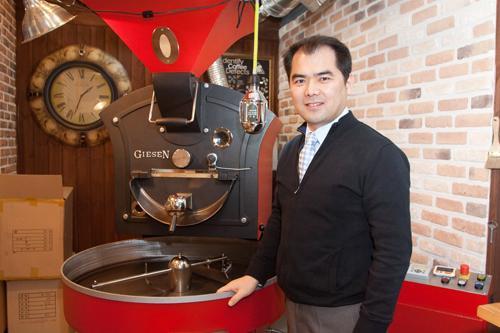Coffee aficionado Choi Seong-il still remembers when instant coffee usually was all one could get for a java fix.
“People just did not know how to enjoy a good coffee,” he says while preparing an espresso in a coffee shop in southern Seoul.
That was 25 years ago. The delicious dark brew has come a long way since then.
According to World Resource Institute statistics, the per capita coffee consumption in Korea has grown four fold in 25 years since the early 1980s to around two kilograms a year. The average consumption has been growing by more than 10 percent lately. Data from the Korean Customs Service shows coffee imports in Korea are increasing, particularly in value. The first 11 months of 2011 saw imports of 107,000 tons of coffee products worth almost $580 million, compared to products weighing 117,000 tons and worth $416 million in 2010.
Unlike many industrialized nations the market for coffee products and services in Korea is still developing.
“I opened the Seoul Coffee School in 2006,” Choi explains.
 |
Choi Seong-il at his coffee shop. The coffee expert, barista and judge is teaching how to make coffee at the Seoul Coffee School he founded in 2006. (Yonhap News) |
There were only 158 students aiming to become a barista, or professional coffee maker, five years ago, he recalls while taking a sip of freshly brewed espresso. “In 2011 there are around 25,000,” he grins.
One of them is sitting next to him. Since early this year Park Yeong-ho has been enrolled at the Barista School near Bangbae Station, southern Seoul.
“After I got to know a little bit about coffee, it really caught my interest,” Park says. He looks forward to opening his own coffee shop early next year outside of Seoul. The 35-year-old wants a piece of the Korean coffee pie.
But the industry is already saturated with big chains expanding extensively and soaking up customers. For example, the native Korean chain Caffe Bene increased its branches by approximately 50 percent since the middle of this year. According to the company, 730 coffee shops are operating at the moment and the number is rising. A new Caffe Bene is practically opening almost every other day somewhere in Korea.
Yet, internationally, Korea is among a few countries such as China, Russia, Saudi Arabia or South Africa with surging coffee markets. While in countries like India, rising income levels boost instant coffee consumption in urban areas, Korea is already one step further.
While expanding coffee franchises is one example of the growing popularity, making good coffee is also getting recognized as a craft and gives room for highly specialized small businesses.
What baristas say they are experiencing these days is consumers turning to higher quality. For individual owners of small coffee shops focusing on remarkable coffee experiences, the “assembly line-ish” mass production of beverages is not much different from the instant coffee that has been dominant in South Korea for decades. They want to provide a different approach.
Cafes like the one Choi Jee-hye is working in are one example.
 |
At Coffee Namsan, beans are roasted by hand, and except for cafe latte, only hand drip coffees are available. (Yonhap News) |
In a small corner at Namsan Coffee, the young woman is preparing what many crave ― carefully hand-roasted coffee. With her husband Choi Joong-ho, who spent the last couple of years studying the art of coffee roasting, she opened a small coffee business in August.
Seeing his teacher’s coffee business thrive infected him. Even though the couple found the Korean coffee industry pretty much stuffed already, they did not see “many places with good coffee and good beans,” the wife says. Except for the latte they serve inside the small cafe, all coffees are hand dripped and made of excellent quality beans, she notes.
To date, the most expensive brew available in Korea is what some think is a real delicacy: Kopi Luwag as it is known in Indonesia or civet coffee as they call it in the Philippines. While Kopi Luwag from Indonesia is very often produced by caging the raccoon-like animal called a musang and feeding it coffee cherries, the civet coffee from the Philippines is collected from wild musangs living throughout the rainforests. The animal that lives in wide parts of South East Asia usually eats only the best coffee cherries it can find with its very keen sense of smell. Because only the skin and the flesh get digested, the seed or the coffee bean, is excreted.
A musang usually leaves a small pile of beige and green coffee beans in its feces. When this cat poop is roasted, ground and brewed, the particularly mild tasting “cat coffee” and its rarity leads to prices of more than 40,000 won ($34) at some of the best hotels in Seoul.
Among baristas, however, “cat coffee” often isn’t seen as a delicacy. For Choi of Seoul Coffee School, the supply of civet coffee clearly outpaces the production, and obviously, not all of the coffee labeled as such is real civet coffee and therefore not worth the money.
Another reason why the certified coffee judge does not understand the hype for Kopi Luwag: He wants his coffee simple, without additional flavors. No alcohol, syrup or animal digestive tract is supposed to interfere with the beans’ flavors.
“I do not even add sugar to my coffee,” he says.
(Yonhap News)









